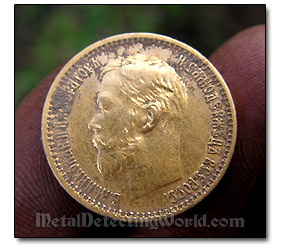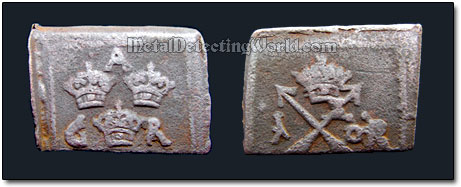Types of Metal Detecting Activities, page 2:
COIN SHOOTING: General Info, Tips and Accessories and Metal Detectors Required

Coin Shooting or Coin Detecting means using a metal detector in search for coins only. Ignoring anything but coins while metal detecting and recovering targets would be ideal for coin shooting, but only a few metal detectors can get close to that in their performance today.
Recovering only coins can be done by using the Dot Discrimination and/or the Multiple Tone ID feature which has over 200 tones (tonal audio responses coming from metallic targets) available for audio target identification. Each tone corresponds to certain conductivity level: the higher the pitch-tone, the higher conductivity of a target.
Some of the rest of regular metal detectors can only allow you to narrow the accepted ranges of targets by NOTCH Discrimination. Some metal detectors still utilize knob-controls for Discrimination. They let you accept only targets that correspond to the conductivity range positioned above one selected level.
The 2-Dimensional Discriminators, utilized in the Minelab FBS metal detectors, allow the detectorist to use various discrimination patterns. By utilizing them, the coin shooter does not hear the audio responses coming from the unwanted (discriminated) targets, i.e. does not hear anything but coin signals. But it is the "Catch-22" as many coins with "questionable" (distorted by near iron nails) signals may be easily rejected (see details in my article "Negative Effects of Discrimination").
If the advanced discriminators are not available, the Multiple Tone ID can help the detectorist decide which targets should be dug up according to their audio tones. Of course, this happens only if the detectorist has learned and memorized the coin signals, and is able to discern them from other signals.
Not all metal detectors that have Tone ID listed among their features actually have the Multiple Tone ID. At best they utilize only three different tones: the low pitch-tone indicates iron targets (lowest conductivity), middle pitch-tone indicates non-ferrous targets of low conductivity, and high pitch-tone indicates the rest of non-ferrous targets. Of course, the 3-Tone or 2-Tone ID is not sufficient for finding coins only; however, more and more Minelab users - coin shooters, now use 2-Tone ID modes, as in Two-Tone Ferrous (TTF) search programs for COINS, to cope with new metal detecting reality - most metal detecting sites have been "hammered to death".
The French XP Metal Detectors company came up with the best combination of the detector's key-features to enable their latest machine - XP Deus, to continue detecting coins at the "hunted-out" sites. These key features include high Operational Frequency (besides other three frequencies available), high Recovery Speed, Customizable Ground Balance, Adjustable (in tone pitch and size) Tonal Zones on the Discrimination scale, which can substitute Discrimination itself, and up to four tones in Target ID. Implementation of these key features brought coin shooting to a new level, and the XP company set new standards in design and ergonomics for metal detectors of the 21st century.
Some experienced coin shooters do not utilize the Tone ID feature and operate their detectors in the Single-Tone mode (all accepted targets sound the same). Thus they solely rely on Discrimination patterns they create and the audio quality of signals (solid vs. broken). Many times, it is necessary to remove the junk before being able to hit the deeper coins.
To be a successful coin shooter, you must learn basic detecting and pinpointing techniques and maintain search coil discipline - all details, secrets and tips are detailed in my "Truth About Search Coils" section as well as in other sections and articles available on this web site.
Coin shooting can be divided in two categories:
1) general coin shooting - when one is searching for any coins available at the hunt site such as a Picnic Grove (for example, you can read my story on Discovery of a Picnic Grove in Upstate New York), and
2) coin shooting for a particular coin type - when the coin shooter purposely adjusts the Discrimination control to accept only one type of coins determined either by coin denomination, rarity rating or coin metal content (gold, silver, copper or alloy).
Example of a Rare Coin - Swedish Rectangular (Clippe or Klippingar) 1625 1 Öre Coin of King Gustav II Adolf

One effective way of gaining access to various properties to be searched for coins is to place an ad in your local "Penny Saver" advertisement booklet. Placing ads that offer to find lost items can "open many doors" and provide a long line of metal detecting projects for you!
You may want to read my story on Coin Shooting at Swedish Tavern Site.